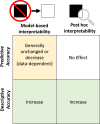Definitions, methods, and applications in interpretable machine learning - PubMed (original) (raw)
Definitions, methods, and applications in interpretable machine learning
W James Murdoch et al. Proc Natl Acad Sci U S A. 2019.
Abstract
Machine-learning models have demonstrated great success in learning complex patterns that enable them to make predictions about unobserved data. In addition to using models for prediction, the ability to interpret what a model has learned is receiving an increasing amount of attention. However, this increased focus has led to considerable confusion about the notion of interpretability. In particular, it is unclear how the wide array of proposed interpretation methods are related and what common concepts can be used to evaluate them. We aim to address these concerns by defining interpretability in the context of machine learning and introducing the predictive, descriptive, relevant (PDR) framework for discussing interpretations. The PDR framework provides 3 overarching desiderata for evaluation: predictive accuracy, descriptive accuracy, and relevancy, with relevancy judged relative to a human audience. Moreover, to help manage the deluge of interpretation methods, we introduce a categorization of existing techniques into model-based and post hoc categories, with subgroups including sparsity, modularity, and simulatability. To demonstrate how practitioners can use the PDR framework to evaluate and understand interpretations, we provide numerous real-world examples. These examples highlight the often underappreciated role played by human audiences in discussions of interpretability. Finally, based on our framework, we discuss limitations of existing methods and directions for future work. We hope that this work will provide a common vocabulary that will make it easier for both practitioners and researchers to discuss and choose from the full range of interpretation methods.
Keywords: explainability; interpretability; machine learning; relevancy.
Conflict of interest statement
The authors declare no competing interest.
Figures
Fig. 1.
Overview of different stages (black text) in a data–science life cycle where interpretability is important. Main stages are discussed in Section 3 and accuracy (blue text) is described in Section 4.
Fig. 2.
Impact of interpretability methods on descriptive and predictive accuracies. Model-based interpretability (Section 5) involves using a simpler model to fit the data which can negatively affect predictive accuracy, but yields higher descriptive accuracy. Post hoc interpretability (Section 6) involves using methods to extract information from a trained model (with no effect on predictive accuracy). These correspond to the model and post hoc stages in Fig. 1.
Similar articles
- Explainable Machine Learning Framework for Image Classification Problems: Case Study on Glioma Cancer Prediction.
Pintelas E, Liaskos M, Livieris IE, Kotsiantis S, Pintelas P. Pintelas E, et al. J Imaging. 2020 May 28;6(6):37. doi: 10.3390/jimaging6060037. J Imaging. 2020. PMID: 34460583 Free PMC article. - On the interpretability of machine learning-based model for predicting hypertension.
Elshawi R, Al-Mallah MH, Sakr S. Elshawi R, et al. BMC Med Inform Decis Mak. 2019 Jul 29;19(1):146. doi: 10.1186/s12911-019-0874-0. BMC Med Inform Decis Mak. 2019. PMID: 31357998 Free PMC article. - A framework for vehicle quality evaluation based on interpretable machine learning.
Alwadi M, Chetty G, Yamin M. Alwadi M, et al. Int J Inf Technol. 2023;15(1):129-136. doi: 10.1007/s41870-022-01121-6. Epub 2022 Nov 27. Int J Inf Technol. 2023. PMID: 36466771 Free PMC article. - Opening the Black Box: The Promise and Limitations of Explainable Machine Learning in Cardiology.
Petch J, Di S, Nelson W. Petch J, et al. Can J Cardiol. 2022 Feb;38(2):204-213. doi: 10.1016/j.cjca.2021.09.004. Epub 2021 Sep 14. Can J Cardiol. 2022. PMID: 34534619 Review. - Interpretable machine learning methods for predictions in systems biology from omics data.
Sidak D, Schwarzerová J, Weckwerth W, Waldherr S. Sidak D, et al. Front Mol Biosci. 2022 Oct 17;9:926623. doi: 10.3389/fmolb.2022.926623. eCollection 2022. Front Mol Biosci. 2022. PMID: 36387282 Free PMC article. Review.
Cited by
- Harnessing interpretable machine learning for holistic inverse design of origami.
Zhu Y, Filipov ET. Zhu Y, et al. Sci Rep. 2022 Nov 11;12(1):19277. doi: 10.1038/s41598-022-23875-6. Sci Rep. 2022. PMID: 36369348 Free PMC article. - Efficient nonparametric statistical inference on population feature importance using Shapley values.
Williamson BD, Feng J. Williamson BD, et al. Proc Mach Learn Res. 2020 Jul;119:10282-10291. Proc Mach Learn Res. 2020. PMID: 33884372 Free PMC article. - Augmenting interpretable models with large language models during training.
Singh C, Askari A, Caruana R, Gao J. Singh C, et al. Nat Commun. 2023 Nov 30;14(1):7913. doi: 10.1038/s41467-023-43713-1. Nat Commun. 2023. PMID: 38036543 Free PMC article. - Recent Methods for Evaluating Crop Water Stress Using AI Techniques: A Review.
Cho SB, Soleh HM, Choi JW, Hwang WH, Lee H, Cho YS, Cho BK, Kim MS, Baek I, Kim G. Cho SB, et al. Sensors (Basel). 2024 Sep 29;24(19):6313. doi: 10.3390/s24196313. Sensors (Basel). 2024. PMID: 39409355 Free PMC article. Review.
References
- Litjens G., et al. , A survey on deep learning in medical image analysis. Med. Image Anal. 42, 60–88 (2017). - PubMed
- Brennan T., Oliver W. L., The emergence of machine learning techniques in criminology. Criminol. Public Policy 12, 551–562 (2013).
- Goodman B., Flaxman S., European Union regulations on algorithmic decision-making and a “right to explanation”. arXiv:1606.08813 (31 August 2016).
Publication types
LinkOut - more resources
Full Text Sources
Other Literature Sources

